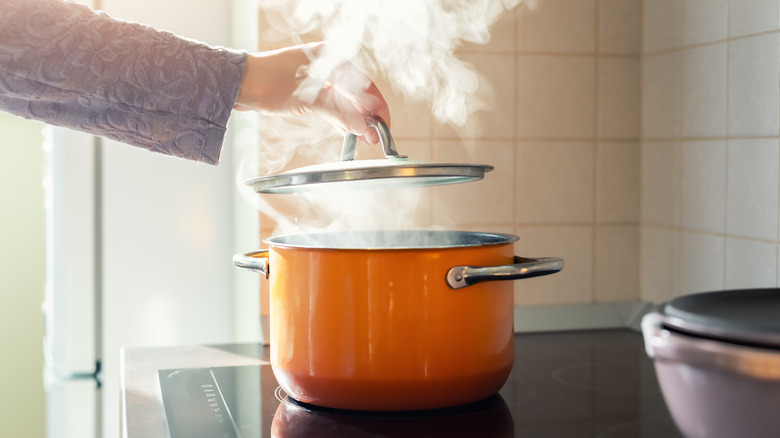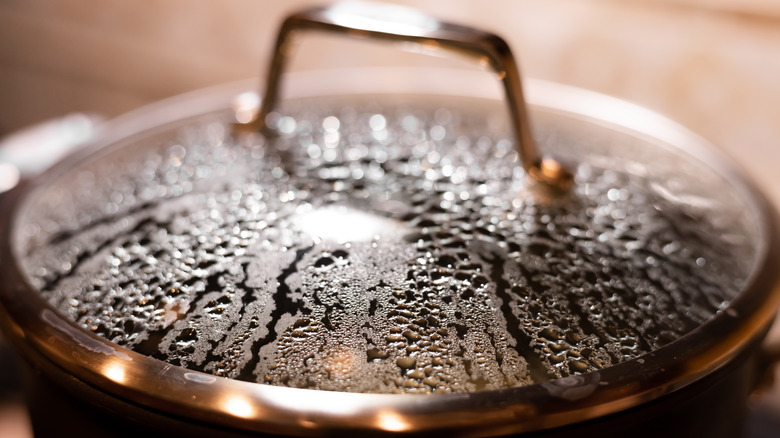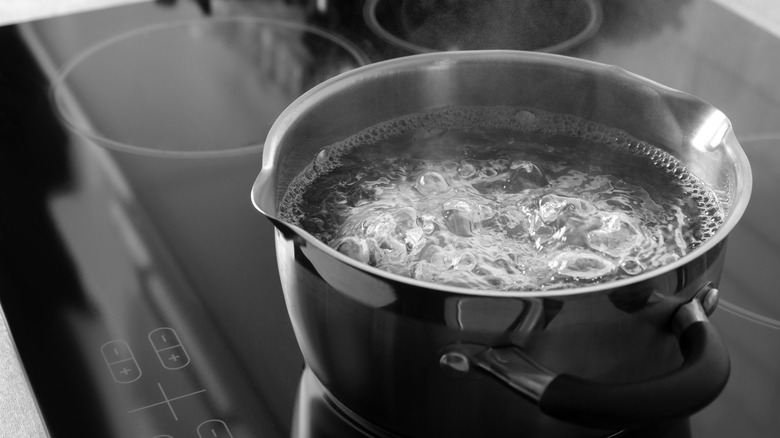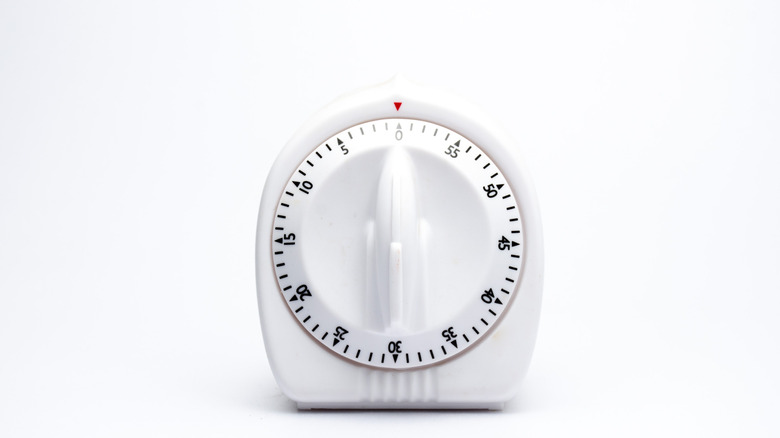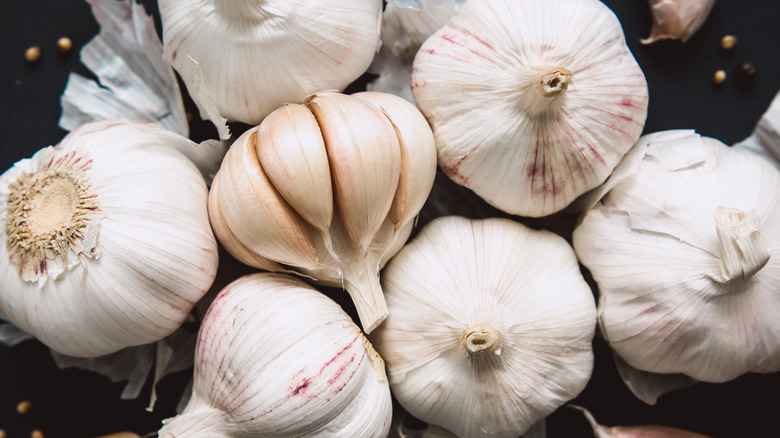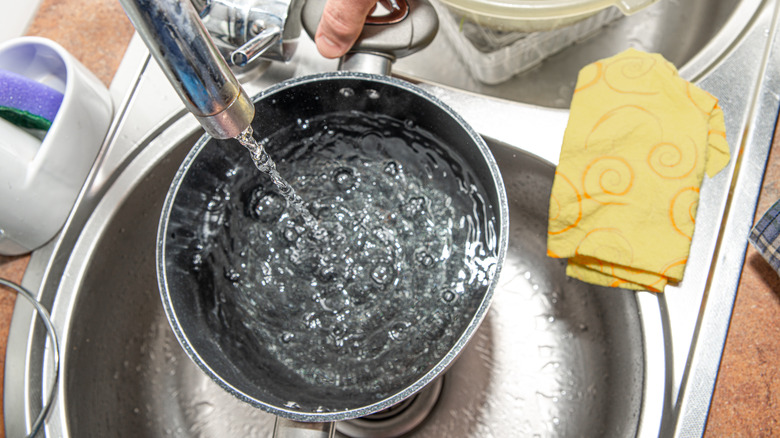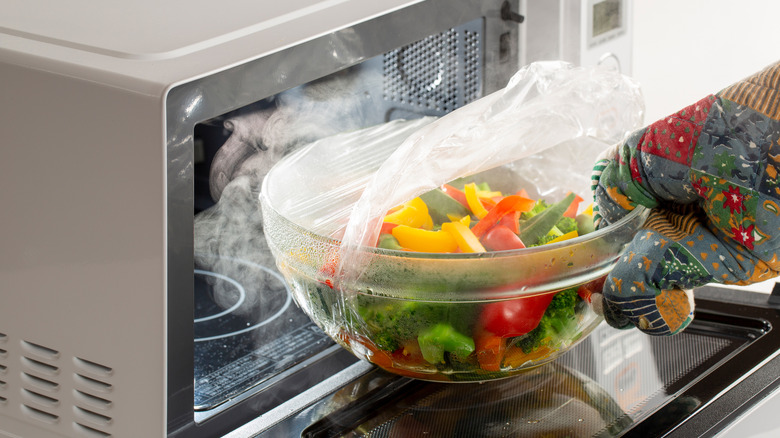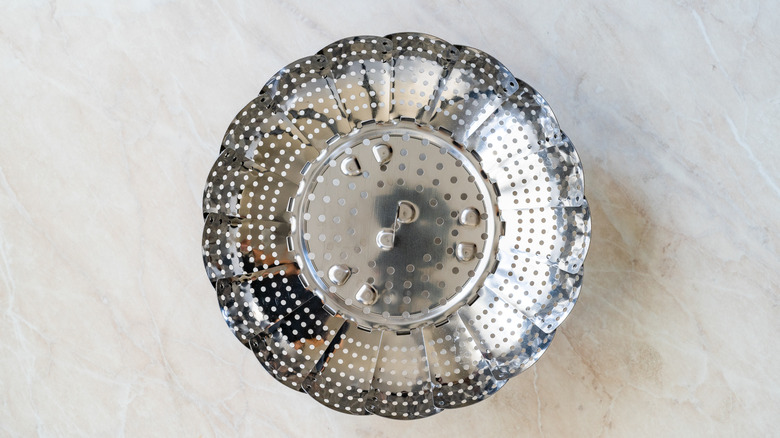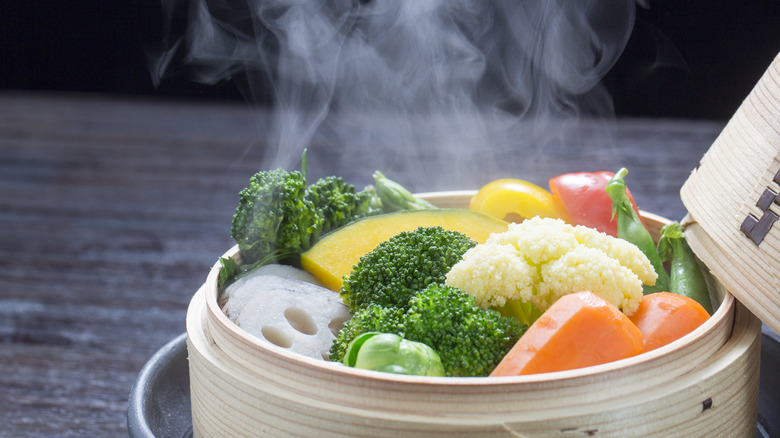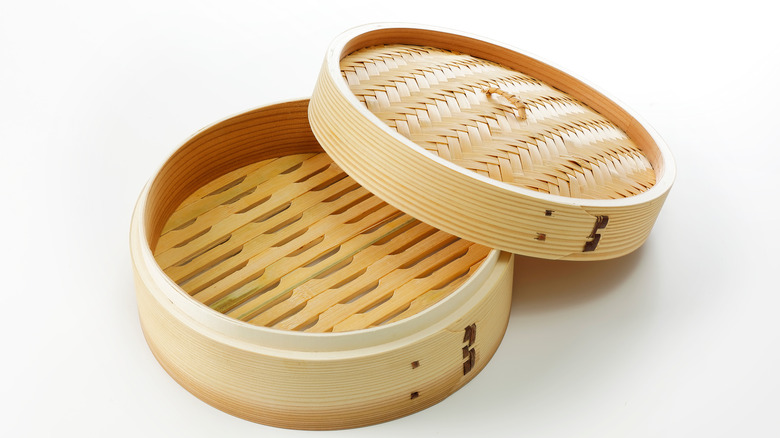Mistakes Everyone Makes When Steaming Food
Steaming is one of the easiest, yet most often overlooked, cooking methods. A lot of people unnecessarily shun the steam. Maybe it's because they associate steaming with steamed vegetables and immediately think "boring"? The reality is, this "moist-heat cooking technique," as explained by The Spruce Eats, is arguably superior to boiling because it's less disruptive to the food item. For example, delicate noms like shellfish remain intact and maintain their nutrients better, and the same goes for vegetables.
While the art of steaming is fairly easy to execute, there are still a lot of recurring mistakes at-home chefs make in the process. Whether you're steaming in a basket over a pot, in a pan with liquid and a lid, or using parchment packets on the grill, we're going to dive into some steaming do's and don'ts, so your next batch of dumplings (yes, you can and should steam those too) is without a doubt love at first bite.
Mishandling the pot lid
Not everyone practices proper lid etiquette while steaming. The lid should always be on and fitted tightly during the process, so the steam has the confined space necessary to cook the grub thoroughly. There should be some space between the food and the lid so the steam can circulate all around it. Don't make the mistake of piling the food so high in the basket that it grazes the underside of the lid.
As culinary scientist and author Jessica Gavin points out, one of the most crucial steaming components is keeping the lid on tight so that the steam can do its job. Steaming cooks food fast, so depending on what you're making and how much of it is in the basket, there really isn't a need to check halfway through cooking time. (Broccoli shouldn't take any longer than seven minutes, for example, and can be done in as little as three, per Simply Recipes.) Gavin notes that if you're using a lid that's clear, you can easily see how the steam job is coming along, but an opaque cover is a little trickier. You can slightly crack it to check if necessary, but it's not advisable. The only other instance where you might need to lift the lid is adding another food to the basket that requires less steaming time than the first item.
Adding food to the basket before the water boils
While steaming is a super straightforward cooking method, it's important to be very deliberate about timing. According to The Seattle Times, it's a mistake to place the food in the basket over the water before the water has started boiling, or while the water is heating up. It's much more effective to wait for the water to start boiling, then add the food to the basket and seal the pot with a lid. If you don't have a lid handy, use aluminum foil.
If you fill the pot with water, place the basket in the pot, seal the pot, and then turn on the stove to start heating the water, there is a chance you might overcook whatever you're making as the pot begins to boil. If you don't start cooking until the water is at a rapid boil, it's easier to stick to a precise cooking time, especially if you're going by a particular recipe.
Steaming the food for too long
Steaming is an extremely fast cooking method, so oversteaming is a common misstep. Overcooking the slightest can result in a mushy mess you won't want to serve your guests or family. You can easily avoid oversteaming if you keep a few things in mind. The Kitchn recommends always setting a timer and, when it dings, testing to see if you can easily puncture the veggies with a knife to confirm doneness. Steam times vary based on the food, but it gets even more specific than that. For example, if you're steaming various vegetables, some take longer than others, so you need to add them to the basket at different times.
Bamboo steamers are a popular steamer tool because you can use the stacking technique for different veggies. The ones that take a little longer to cook can rest on the bottom tier. After a certain amount of time, you can take off the lid, add another tier with vegetables that require less cooking time, then reseal the basket (via Bon Appétit).
Not cutting the vegetables purposefully
While haphazardly chopping vegetables might be a passable tactic if you're tossing them into a pan for the stove or oven, it's a definite no-no if you're steaming. You need to be deliberate about your chopping technique. If you're just steaming one kind of vegetable, cutting them into the same size pieces ensures they all cook at about the same rate and time, The Kitchn explains. You don't want to have to wait for the larger slice of squash to catch up to the scrawnier piece of squash.
If you're steaming more than one kind of vegetable, and one type takes longer than the other (carrots will take a little longer than broccoli, for example), make sure to cut not only the longer-to-steam vegetable in a uniform size but also a smaller size. The smaller the bite or hunk of veggie, the quicker it will steam (via Epicurious).
You skip the aromatics
If you hear the word "steamed" and immediately conjure images of bland food, you might be missing an important element when you steam. People often employ steaming because it does not require added calories such as cooking oil or butter, but that doesn't mean you can't season the food. While it might seem like seasoning is only for baked or grilled foods, that couldn't be further from the truth.
While steaming tends to thoroughly maintain the original flavor of the food, adding aromatics such as garlic, ginger, onions, or other herbs, just to cite a few examples, can drastically alter the outcome of your steamed dish. The experts at Fine Cooking suggest steaming the aromatics along with the food or even adding them to the water before boiling. The former tends to yield a more intense flavor, however. Another option is marinating the items you're steaming in a sauce prior to the actual steaming.
Adding too much or too little water
If you are steaming food in a basket over boiling water in a pot, the food should never come in contact with the actual water, but rather just the vapor of the steam coming off it. So you never want to add too much water, but you also don't want to add too little that it evaporates before properly steaming your food. According to Today, the water should be about one to two inches below the basket, but the bottom of the basket should not graze any part of the water's surface.
The same goes if you're planning to simultaneously steam while sautéing. You can toss some water or broth into a sauté pan, put a lid over it, and steam (viaThe Kitchn). There needs to be just enough liquid to hit the hot pan and evaporate into steam but not so much that it drowns the food in the pan.
Not taking advantage of steaming in the microwave
The microwave is convenient for reheating leftovers, popping popcorn, and heating your favorite frozen meals. It can also steam food in a pinch. If you want to steam some veggies, for example, and don't want to hassle with busting out a giant pot and the steamer basket, it's a fallacy to think you're out of luck when you've got a microwave in your kitchen.
Place the vegetables in a microwave-safe bowl, then add about 1 tablespoon of liquid. Cover the bowl with a microwave-safe plate or plastic wrap, then get to nuking. The only thing to remember is that results may vary per vegetable. The vegetables also might shrivel slightly after microwave-steaming, and they will likely steam faster than on the stove, so keep an eye on them, so they do not overcook (via Epicurious). Other than that, microwaving veggies is a great way to steam them without the fuss.
Assuming you always have to use a steamer basket
There are so many different ways to steam that it's often wrongfully assumed that you have to have a special basket to get the job done. Even a pot, while definitely helpful and usually the default vessel for steaming, is not the only way. For example, steaming can be done in carefully curated parchment pouches enclosed with food and liquid over an oven or stove, just as easily as it can be done in an electric steamer.
You can even create a makeshift steamer by getting crafty with tin foil and a heat-proof plate. There are also effective steaming methods involving a disposable aluminum pie plate, elevated cooling rack, and even the microwave, per Food Network. You can also steam in an Instant Pot (via The Washington Post). Choosing a non-traditional steaming method might depend on what you're cooking, and how much work you're willing to put into it.
A steamer basket is still really inexpensive and easy to find, so it might be worth investing in one, but don't fall prey to the belief that it's necessary for this cooking method.
Steaming food that is too bulky
While you might get super excited to steam anything and everything in sight, you do need to be selective about what you decide to cook with this technique. It's a speedy way to make food, but that convenience comes with some risk.
According to culinary experts consulted by The Washington Post, steaming can almost be efficient to a detriment. The steam is so hot and can cook the outer surface of the food item so quickly that the inner part of the item does not have time to catch up, so to speak. This might leave you with an overcooked outside and undercooked inside. As a result, it's a mistake to try to steam super bulky or large foods, especially if you don't prep them with a lot of chopping. The thinner and smaller the pieces you're steaming, the better. It's not impossible to steam thick items, but being deliberate about how they're cut is essential.
Not lining a bamboo steamer basket
Bamboo steamer baskets are a long-standing, effective way to steam food. They're great for dumplings, vegetables, and everything in between. Just don't forget to line the bottom of the bamboo steamer. The nature of the bamboo material yields to food sticking to it very easily. Even further, you already risk the bamboo basket absorbing the scent of whatever you steam in it (especially fish), so it's important to create a barrier there. Lettuce and cabbage are naturally porous, so they can be used as natural liners. Other creative liners such as corn husks or grape leaves are an option too, and they add additional flavor to the food you're steaming, per The Kitchn.
If you go with parchment paper as a lining, the key is to make sure there are holes poked into it to allow the steam to reach the food. Luckily, there are steamer liners (similar to what you'd use in an air fryer) available that come with holes already in them.
